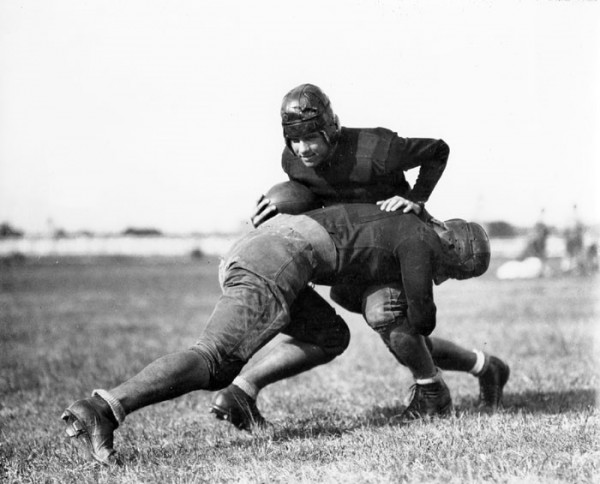Super Bowl 50 is this weekend. Amid all the pageantry, hoopla, multi-million dollar players and multi-billion dollar franchises, it’s easy to forget the NFL’s humble beginnings and the role manufacturers played at the start. Even more forgotten is the small but interesting part that WNY had in the earliest days of the league, long before the advent of the Buffalo Bills.
The NFL began life in 1920 as the American Professional Football Association (APFA) and apparently numbered the “Buffalo All-Stars” among its teams that year.[i] In 1921, Buffalo posted a 9-1-2 record and claimed the first APFA championship, but the Decatur Staleys (later the Chicago Bears) went 9-1-1 and, without a playoff in place, the commissioner awarded the Staleys the championship. Perhaps Buffalo’s 1921 performance was helped by their acquisition the previous year of tackle Bob Nash from Akron for $300 and 5% of gate receipts, the NFL’s first player deal.
In that same 1921 season, Tonawanda also fielded an NFL team known at various times as the Tonawanda Kardex, Lumberjacks and Lumbermen. In those days it was common for teams to be owned or sponsored by local manufacturers, hence the Moline Universal Tractors, Green Bay Packers and Kewanee Walworth named for a steel tube company.[ii] Apparently the Tonawanda team was sponsored by Tonawanda Kardex, an office equipment manufacturer founded by James H. Rand, Jr., a larger-than-life character who had himself played football at Harvard. Rand began his career working for his father at the Rand Company, creator of the Visible Ledger products. After a falling-out, the younger Rand started Kardex to make metal filing cabinets and built it into a successful enterprise. After reconciling with his father and merging their companies in 1925, Rand went on a 30-year merger and acquisition spree combining with Remington Typewriter to form Remington Rand and Sperry Corporation to form Sperry-Rand before ultimately morphing into UNISYS. Along the way, Rand owned the UNIVAC computer, installed General Douglas MacArthur as Chairman after he was cashiered by President Truman during the Korean War and employed General Leslie Groves, who oversaw the Manhattan Project to build the atom bomb. Rand was also “credited” with authoring the Mohawk Valley formula, a notorious union busting strategy that emphasized propaganda rather than violence, in response to a strike that began at a Rand plant in Ilion, NY in 1936.
As for Tonawanda Kardex, they began life as the All-Tonawanda All-Stars in 1916 under Walter “Tam” Rose, a former Syracuse football captain and All-American, who coached the team throughout its brief history. Tonawanda played in the New York Pro Football League[iii] and was quite successful, winning the championship in 1917. In 1920, Tonawanda posted a 7-1 record, their only loss was to the Buffalo All-Stars. That year Tonawanda defeated the Rochester Jeffersons 14-3 on Thanksgiving, the “first year of the NFL Thanksgiving tradition” according to Aaron Allermann. In 1921, the APFA began to crack down on the scheduling of games with non-league teams, so Tonawanda bought a franchise license for $50 and joined the NFL. But the Kardex only played one game, losing to the Rochester Jeffersons, in Rochester, 45-0 on November 6, 1921 in front of 2,700 fans. It was the worst defeat in Tonawanda’s history and a clear indication that Kardex could no longer compete. Tonawanda was literally one-and-done, becoming the NFL’s shortest-lived team. Let’s hope the Bills can bring us a different sort of NFL distinction one of these days.
[i] http://www.nfl.com/history/chronology
[ii] http://adamunderhill.wordpress.com/2012/09/09/
[iii] http://allerman.blogspot.com/2010/11/tonawanda-kardex.html

